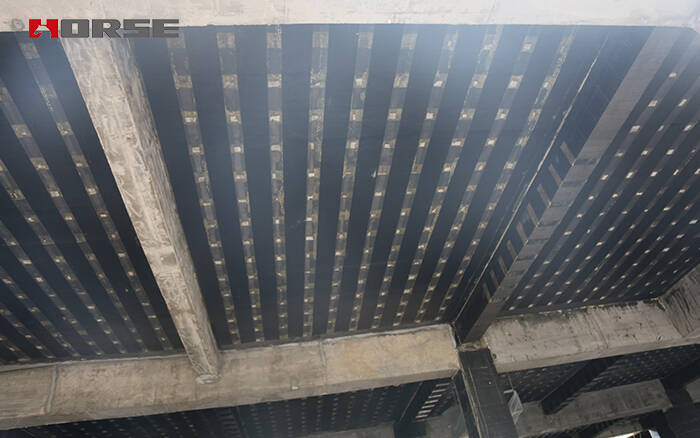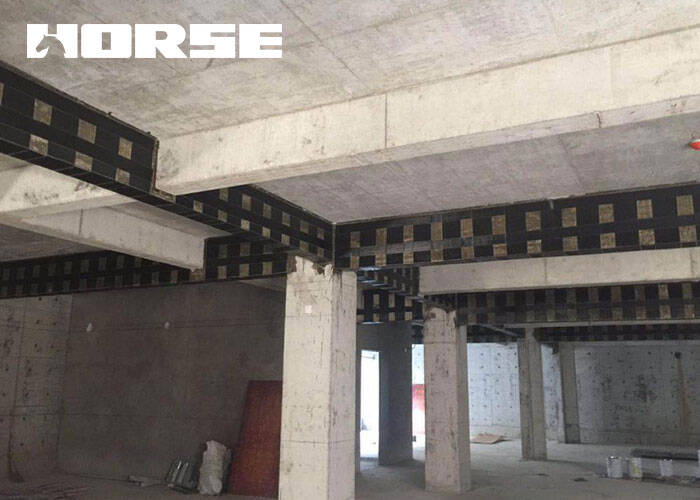Carbon Fiber Strengthening
The carbon fiber reinforced concrete technology reinforces the beams and slabs of the original two floors in a large area.
The beams and slabs on the second floor of the Zhuanghe Xintiandi Commercial City have been reinforced with carbon fiber to meet the owner's requirements. Due to the economic and technical validity, they will be widely used in actual projects.

1. Project Overview
The Zhuanghe Xintiandi Commercial City project has three floors above ground, with a construction area of 49,606 square meters, and a reinforced concrete frame structure. Design began in October 2006, and construction began in March 2007. The construction of the main structural project was completed in August 2007. In October 2007, during the process of investment promotion, the owner changed the use function. The use load of about 5000 square meters on the third floor increased from the original design 5KN/m2 to 7KN/m2.
After checking and calculating by the original design unit, the foundation and columns have sufficient bearing capacity, and the beams and slabs have insufficient flexural and shear capacity, so reinforcement is needed.
After discussion and research by all parties involved in the project, it was decided to use carbon fiber strengthening technology to reinforce the beams and slabs of the original second floor in a large area.
2. Material performance
Carbon fiber has the highest strength among known engineering materials in the world, and it is particularly prominent that it has extremely high tensile strength and elastic modulus. The specific gravity of carbon fiber cloth made of composite material is reduced to one-fifth of steel. It is a very light material and at the same time, it is a new material with excellent mechanical properties. The carbon fiber used in engineering is made of high-purity polyacrylonitrile (PAN) as the raw material, processed into very fine fiber filaments through special processes such as high-temperature carbonization, which greatly increases the surface area of a certain amount of fiber and is more conducive to strengthening the bond with the gum. During construction, the resin glue fully penetrates between the fibers to completely wrap each fiber filament to form a composite material with excellent physical properties. Tests have proved that the tensile strength of carbon fiber can reach more than 4500N/mm, and after forming a composite material, it is more than 3500N/mm, which is about 9 times and 7 times that of ordinary alloy structural steel. The modulus of elasticity of carbon fiber composite is slightly higher than that of ordinary steel, and it also has excellent corrosion resistance. It is especially suitable for structural reinforcement projects in coastal areas with high chloride ion content in the air.

3. Principles
3.1 General principles of carbon fiber design
(1) During the design, the carbon fiber cloth is converted into the amount of steel bars according to the strength, and the synthesized section is calculated according to the same method as the bending calculation of reinforced concrete members to jointly resist the dynamic load caused by the design external force and the increased static load;
(2) The calculation theory adopts the limit state method to calculate the bearing capacity limit state and serviceability limit state:
(3) The carbon fiber is arranged along the direction of the main reinforcement where the strength of the reinforced concrete member is insufficient;
(4) Closed type, U-shape or side sticking can be used for shear reinforcement; the fiber direction should be perpendicular to the axis direction.
3.2 Basic assumptions for calculation of ultimate bearing capacity of flexural members
(1) The effect of concrete in the tension zone is ignored;
(2) After the beam is bent, the strains of concrete, steel, and carbon fiber conform to the assumption of flat section;
3.3 General construction requirements
(1) The carbon fiber should be pasted to the lower edge of the tension zone of the beam. If it needs to be pasted to the side of the beam, it should be limited to 1/4 of the beam height. The area of the carbon fiber on the side should be multiplied by the factor;
(2) The number of carbon fiber bonding layers should not exceed five; for multi-layer carbon fiber, the reduction of the co-working coefficient should be considered. Too many carbon fiber layers will lead to brittle failure of the concrete structure;
(3) The effect of strip bonding and reinforcement of carbon fiber is better than that of whole width bonding;
(4) The carbon fiber paste should be reliably anchored, and the anchoring length should be determined by calculation, and additional anchoring facilities can be added when necessary;
(5) The part where the fiber cloth is connected (lengthened) adopts an overlapping structure. The length of the overlap part is that the overlap length of the carbon fiber cloth along the fiber direction shall not be less than 150mm. The ends of the carbon fiber cloth shall be fixed with transverse carbon fiber or pasted steel.
4. Technical and economic comparison
Compared with other reinforcement materials, carbon fiber materials have the following advantages:
4.1. High strength and high efficiency. The tensile strength of carbon fiber composite materials exceeds 3500mMpa, the tensile strength is about 10 times that of steel, and the tensile modulus of elasticity exceeds 2.35×105Mpa, which is similar to that of steel bars, and is suitable for the reinforcement and repair of concrete structures. Inhibit the growth of cracks, improve and optimize the strength and toughness of concrete, and extend the service life.
4.2. Corrosion resistance. Carbon fiber materials are chemically stable and do not react chemically with acids and alkalis. Therefore, reinforced concrete members made of carbon fiber materials have good corrosion resistance and durability.
4.3. Without increasing the weight and volume of the components, the specific gravity of carbon fiber is only 1/4 of that of steel. The thickness is less than 0.5mm, so it can exert a strong reinforcement effect without increasing the weight and cross-sectional size of the original structure.
4.4. Good fatigue resistance. The fatigue strength of carbon fiber composites is higher than that of high-strength wire. Under the action of communicative variable stress, the fatigue limit of metal materials is only 30%-40% of the static load strength. Because fiber and basic composite can ease crack growth and the possibility of fiber internal force redistribution, the fatigue limit of composite materials is relatively high, about 70%-80% of static load strength, and there are significant signs of deformation before failure.
4.5. Wide application. It can be widely used in structural reinforcement and seismic reinforcement of beams, columns, slabs, walls and other components of industrial and civil buildings and railway, highway bridges, tunnels, elevated roads, chimneys and other structures. It can be used to strengthen complex structures such as curved surfaces and nodes.
4.6. Easy to construct. In the carbon fiber cloth reinforcement project, the construction process does not require large construction machinery, and the construction site is small, there is no wet work, and the work efficiency is high.
The beams and slabs on the second floor of the Zhuanghe Xintiandi Commercial City have been reinforced with carbon fiber to meet the owner's requirements. Due to the economic and technical validity, they will be widely used in actual projects.